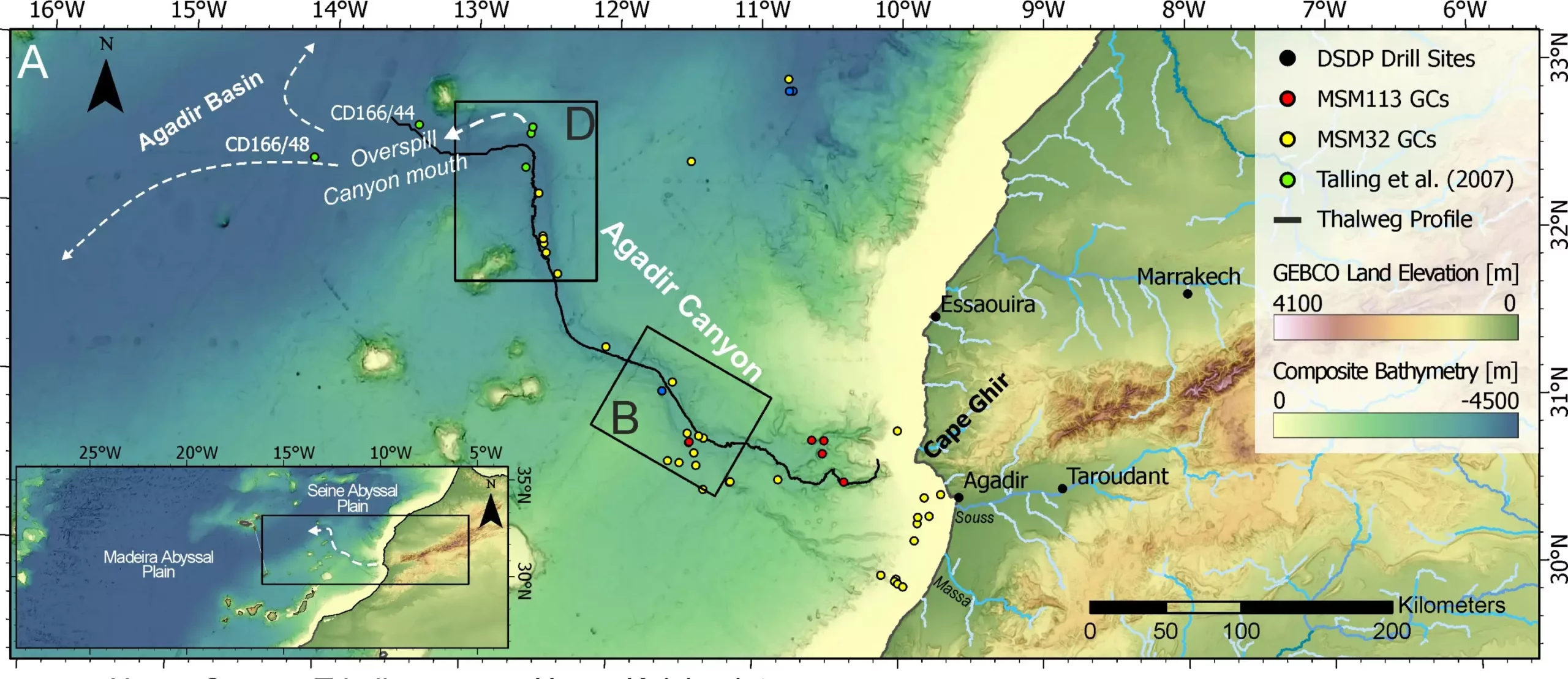Underwater avalanches, despite their formidable power, have often remained an enigma within the geological community. The recent study spearheaded by the University of Liverpool offers a groundbreaking understanding of how these colossal geological phenomena operate, specifically detailing a cataclysmic underwater event that wreaked havoc across the seafloor of the Atlantic Ocean. This endeavor has shifted perceptions about underwater avalanches, especially regarding their size and the means through which they evolve.
The research, which finds its home in the esteemed journal *Science Advances*, particularly concerns a massive underwater avalanche that occurred in the Agadir Canyon nearly 60,000 years ago. Initially, the event began as a relatively modest seafloor landslide, characterized by a volume of only 1.5 km. As it progressed, however, this avalanche exhibited an astonishing growth factor, escalating in size over 100 times. The documentation of this phenomenon marks a significant achievement in the geological sciences, providing a comprehensive mapping of the event—a feat that had never been accomplished on such a grand scale.
The avalanche’s trajectory stretched a staggering 2,000 kilometers, during which it accumulated immense amounts of sediment, rocks, and marine debris. The enormity of the event is highlighted by its capacity to erode a remarkable 400 km of canyon length, reaching heights of 200 meters as it charged forward at approximately 15 meters per second. In a vivid metaphor, Dr. Chris Stevenson compares the avalanche’s destructive path to that of a skyscraper barreling along the landscape at speeds exceeding 40 mph.
One key aspect that this research underscores is the dynamic nature of underwater avalanches. Unlike their terrestrial counterparts, which manifest as visible landslides or snow avalanches, underwater avalanches operate silently and invisibly. This characteristic complicates the monitoring and analyzing of such events, making it a significant challenge for scientists to quantify their impact. However, their significance should not be understated; underwater avalanches play a crucial role in redistributing sediments, nutrients, and pollutants across the marine environment, hence serving as a vital mechanism in oceanography.
The study also hints at a broader pattern where underwater avalanches can start from smaller disturbances yet grow exponentially, unlike traditional debris flows that see limited growth. This behavior suggests that even minor triggers can lead to significant underwater events, emphasizing the need for a reevaluation of how these geological phenomena are studied. Dr. Christoph Bottner’s insights further the understanding of these transformations, suggesting that the extreme growth witnessed in this study may be a typical characteristic of underwater avalanches.
The implications of this delicate yet powerful phenomenon extend beyond academic curiosity. Understanding the sheer scale and force of underwater avalanches carries critical importance, especially concerning modern infrastructure. Many coastal and oceanic structures, particularly internet cables and communication lines, are susceptible to damage from such natural occurrences. The study’s revelations about the potential for large-scale destruction point to the necessity for updated risk assessments regarding these undersea systems.
Professor Sebastian Krastel articulates the urgency of incorporating these findings into the broader landscape of geohazard research. The gathering of data through extensive core sample analysis, as conducted over the past 40 years, has furnished researchers with an invaluable repository of information. Such proactive measures will not only protect existing structures but also pave the way for new constructions to consider the powerful forces at play beneath the ocean’s surface.
The implications of this study open new avenues for future research into underwater Avalanches. The findings call for a deeper investigation into the evolutionary patterns of these events, potentially leading scientists to understand better the triggers that set them in motion. With the potential for extreme growth identified, researchers must prioritize the development of methodologies that can predict and model underwater avalanches more effectively.
Ultimately, as the geological sciences continue to evolve, so too must our understanding of the forces acting upon our planet, especially those that transpire below the ocean’s surface. Continual exploration and innovation in this realm are vital to safeguard the intricate balance of our ecosystem while providing critical information about the underlying forces that shape our environment. This groundbreaking study not only enriches our understanding of underwater avalanches but also ignites a crucial conversation about the delicate interplay between natural phenomena and human infrastructure in our ever-evolving world.

